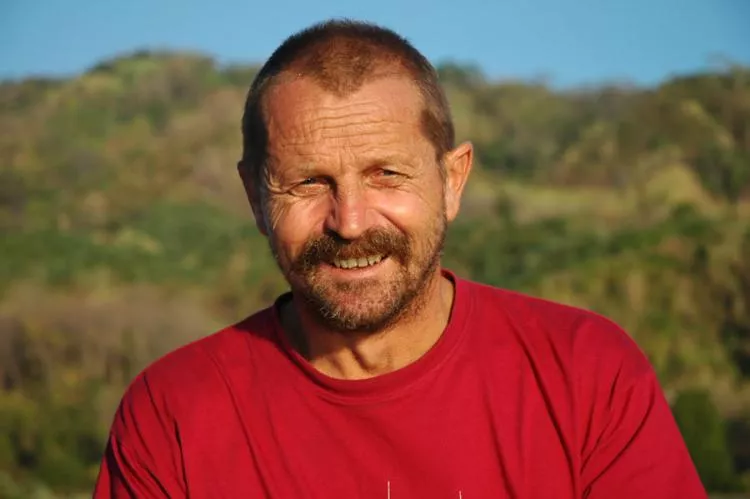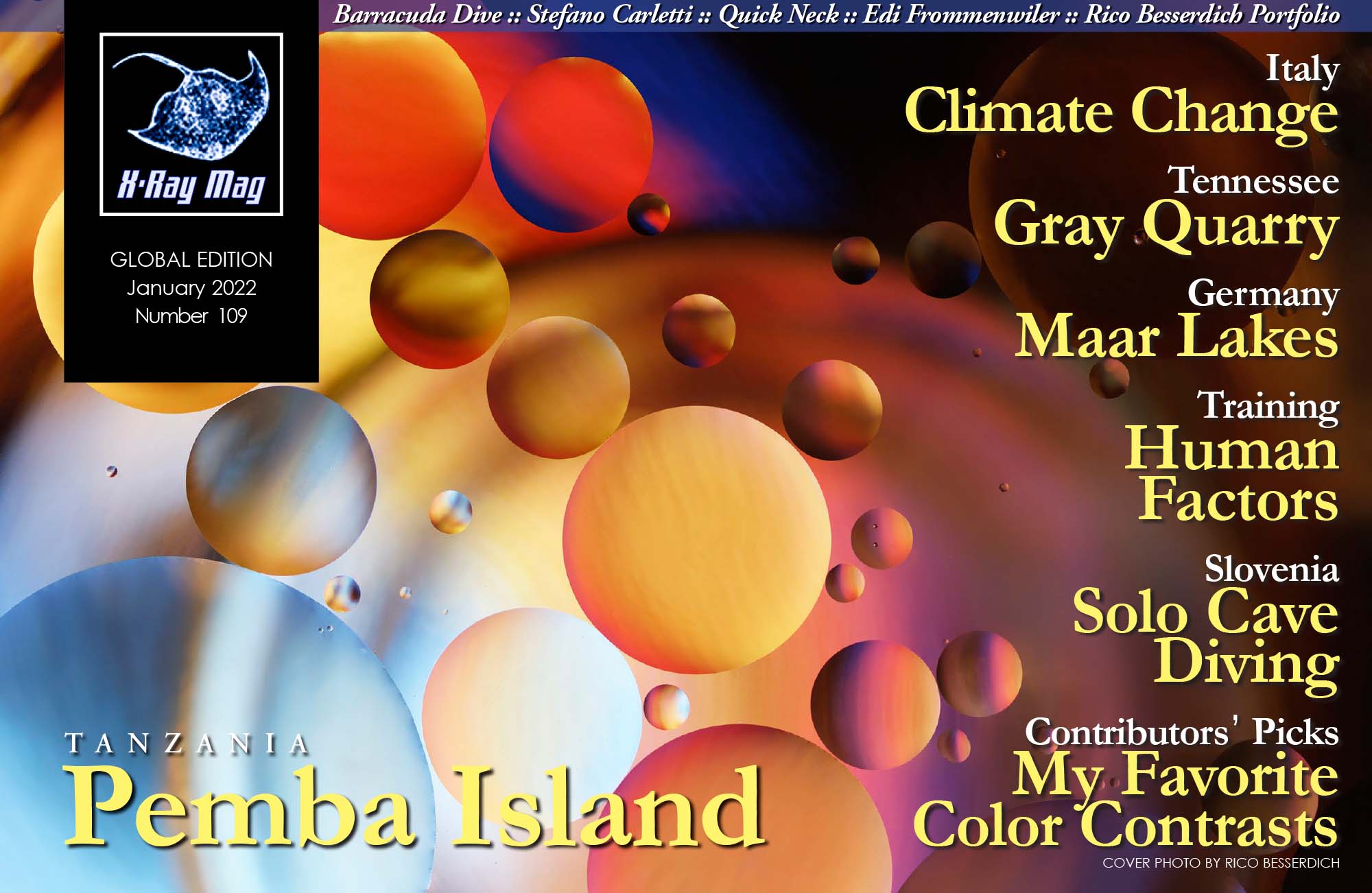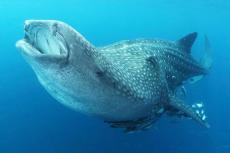Back in 1992, very little was known about Raja Ampat in the Indonesian province of what was then known as Irian Jaya. Edi Frommenwiler had heard rumours about how scenic it was, so he studied the area charts and suspected that with so many islands, there must be some great places to explore underwater. He decided to go there in September that year—a trip which would foster his appreciation for this amazing jewel of an area and build a liveaboard dive boat to explore it. Don Silcock interviewed the adventurer to learn more about his pioneering endeavours.
Contributed by
I have a theory… Completely unproven of course, but very logical (well, to me at least) and it is that true adventurers have seven genotypes, rather than six like the rest of us. Let’s just call it the AA++ genotype, and those individuals with one have inherited an intense desire to explore the world and can never accept a nine-to-five existence.
They tend to embark upon their first big adventures in any way they can, as soon as they can. And, in the case of Edi Frommenwiler, his chance came by driving trucks in his native Switzerland. But we are not talking about delivering stuff to supermarkets or longer hauls across Europe. None of that for Edi; rather, he was delivering heavy machinery and specialist building materials to places like Iraq and Saudi Arabia.
In total, he did 18 of those trips, over a two-year period in the mid-1970s, all while still in his early twenties, enabling him to save enough money for the next stage—two years of almost exclusively overland backpacking. That journey took him to places like Nepal, Burma (before it was Myanmar), Southeast Asia, Australia and New Zealand. Along the way, in 1980, he made his first visit to Indonesia—the country that would become his home and where he would have his biggest and longest adventure!
But in-between the backpacking trip and his biggest adventure, Edi spent 10 years as a tour guide in places like Brazil, Venezuela and Nepal. And occasionally, he returned to Indonesia to take guests to Lamalera, the remote village in Nusa Tenggara where traditional, subsistence whaling was practised.

Indonesia beckons
Edi first heard about Indonesia when he was quite young, from his father who owned a motorcycle repair shop, and had agreed to sponsor a missionary with a bike and spare parts to take to Maumere where he was going to work with the poor. Both the bike and the missionary made it to Maumere where they both became quite well-known—so much so that the locals christened him “Brother Tuk-Tuk.”
It was during those trips to Lamalera that Edi got the idea of building a real boat. Aside from places like Bali, the tourism infrastructure in Indonesia back in the 1980s was almost non-existent. To get his guests to Lamalera, Edi had no other option but to hire local boats, many of which he considered decidedly “dodgy.” A custom-built boat with guest cabins, ensuites and serving good food, which was able to take adventurous tourists to some of the amazing off-the-beaten-track places in Indonesia seemed like a wonderful way to earn a living!
Getting it together…
As most people know, it is one thing to have a good idea but quite another to make it all happen. Having a good idea in Indonesia, and actually making it happen are on completely different scales. Even today, with a pro-business government in Jakarta, achieving success is really tough.
In 1990, it bordered on the almost impossible. But Edi Frommenwiler does not do “impossible” and believes that there is always a way through. So, in May of that year, he went back to Indonesia to work out how and where he could build his boat and how much it would all cost.
Back in Switzerland at the end of June, he embarked on what we would now call crowdfunding. Starting with his family and friends, then following leads which came out of that process, he slowly but surely raised the capital needed to build the boat.
Then in September, he set off for Jakarta, where he spent what he now considers to be possibly the worst three months of his life, living in a small, cheap hotel while he found a way through the labyrinth-like bureaucracy in the nation’s capital—something that was once described to me as akin to swimming in glue.
But succeed he did, and by December, he was in possession of a PMA—the formal permission to conduct business in Indonesia at that time. So highly prized were those PMAs that Edi’s was one of just 20 that were approved and signed by Indonesian President Suharto at the end of 1990!

Building Pindito
In early 1991, Edi moved to Pulau Laut, the large island on the southeastern tip of South Kalimantan in Indonesian Borneo, where he had found the people and materials he needed to build his boat. But first, there were a couple of really important things to get his head around: AutoCAD and the Indonesian Classification Bureau (BKI). Edi had decided to design the boat himself, and to do that, he had to learn the industry-standard AutoCAD software.
For the uninitiated, AutoCAD is fantastic but very complex, and learning it to build your first boat is a bold move—particularly so when you are also learning how to work with the German Lloyds-approved Indonesian BKI marine standards. But fortune favours the bold, and by the end of March 1991, a huge 12m by 30m hole had been dug—by hand—in the clay near the beach to create a drydock, and the boat’s keel had been laid.
Construction continued through 1991, and the boat was safely floated for the first time by breaking through the dry dock wall. By early 1992, Edi had named the boat MV Pindito. And his youngest brother, who was in the travel business in Switzerland, was actively promoting the initial trips on the very first liveaboard in Indonesia.
Raja Ampat
In September of 1992, Edi decided to go and explore Raja Ampat further. It was a trip that led to a shift in the whole rationale for Pindito, changing from a liveaboard island hopper to a liveaboard dive boat.
Obviously, that change came at a cost. But it seemed worth it, as the underwater potential of Raja Ampat appeared to be immense. However, nobody, including Edi, had any idea just how immense it actually was.
Bear in mind that 1992 was before the words “coral” and “triangle” had been associated with each other, and the Indonesian Throughflow was just being quantified and understood. In many ways, Edi’s first trip was like discovering an Indonesian Galapagos hidden in plain sight.
Quite amazingly, for 10 years, Edi had the greater Raja Ampat area to himself, as Pindito was the only boat operating there. The guests who came on the boat during those years were truly experiencing something very unique.
But…
As wonderful as that story is, it was not all kumbaya around the campfire. The very isolation of Raja Ampat meant that its incredible biodiversity and intense marine life was wide open to be pillaged without any recourse.
Edi tells the story about first visiting the remote Ayu Islands in the far north of Raja Ampat around 1993. After dropping the anchor, out from one of the villages, the locals quickly got in their boats and headed for Pindito with their spears and machetes!
Clearly, they were very angry at something, and Edi did not understand what, but sensed the danger around the highly unusual reception. Luckily, Edi’s Indonesian wife Ella was on board and was able to establish a dialogue with the villagers. She learnt that their reefs had been effectively decimated from cyanide fishing carried out by a small fleet of rogue boats.
To put that into perspective, for the villagers on those remote islands, their reefs were their primary source of nutrition, and it was how the fishermen fed their families. The health of those reefs was of paramount importance. And like many fishing communities in Indonesia, the people of the Ayu Islands used Adat traditional practices to manage them and the fish stocks.
To have those rogue fishing boats come in like they did, using cyanide to harvest en masse almost all their fish and damage the reefs in the process was simply life-threatening. So, that was why they were so angry—they thought Pindito was there to do more cyanide fishing!

Conservation—The first shoots
Running the first liveaboard dive boat in Raja Ampat—and for 10 years, the only boat—meant that Edi was able to establish a strong reputation and good relationships with key people. In 1996, the Bupati (regional leader) of the Raja Ampat regency reached out to him, wanting to know what could be done locally to attract more investors and tourism operators to the area. Sensing a unique opportunity, Edi explained the paradox of underwater Raja Ampat, in that its incredibly rich biodiversity was also its biggest threat, as it would be ruthlessly exploited unless it was protected.
It took quite a bit more work, but ultimately, the Bupati asked which parts of Raja Ampat should be protected, so Edi drew some circles on a map of the area. It turned out that the Indonesian government were drawing up a management and development plan for Raja Ampat and had asked the Bupati for his input.
It took a few more years to come together, but in 2004, the first Marine Protected Area (MPA) was established. And over the years since then, another eight MPAs have been put in place, with some two million hectares, or 44 percent of the total 4.6-million-hectare marine area of Raja Ampat, now protected.
It is a source of considerable pride to Edi that those circles he drew on the map for the Bupati form the core areas of that MPA network—particularly so, the one around the Ayu Islands!
More adventure to come
I like to think that I have an adventurous streak and have done a lot of stuff—but whenever I talk to people like Edi Frommenwiler, I start to think that in reality, I have led a sheltered life. The scope and magnitude of what Edi has accomplished is simply tremendous, but what is amazing to me is the passion that still burns deeply within him to discover more of the underwater wonders of the vast Indonesian archipelago. I hope to return to my home in Bali in the coming year and join Edi on one of his exploration trips as he seeks to unlock more secret places, just like he did all those years ago with Raja Ampat!
In more normal times, Don Silcock is based in Bali, Indonesia, but is currently hunkered down in Sydney. To see extensive location guides, articles and images on some of the best diving locations in the Indo-Pacific region and “big animal” experiences globally, please visit his website at: indopacificimages.com.



































